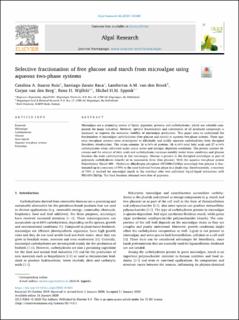Selective fractionation of free glucose and starch from microalgae using aqueous two-phase systems
Suarez Ruiz, Catalina A; Baca, Santiago Zarate; van den Broek, Lambertus A.M.; van den Berg, Corjan; Wijffels, Rene Hubertus; Eppink, Michel H.M.
Peer reviewed, Journal article
Published version

Åpne
Permanent lenke
https://hdl.handle.net/11250/2729299Utgivelsesdato
2020Metadata
Vis full innførselSamlinger
Originalversjon
Ruiz, C. A. S., Baca, S. Z., van den Broek, L. A. M., van den Berg, C., Wijffels, R. H. & Eppink, M. H. M. (2020). Selective fractionation of free glucose and starch from microalgae using aqueous two-phase systems. Algal Research, 46: 101801. doi: 10.1016/j.algal.2020.101801Sammendrag
Microalgae are a promising source of lipids, pigments, proteins and carbohydrates, which are valuable compounds for many industries. However, optimal fractionation and valorization of all produced compounds is necessary to improve the economic viability of microalgae production. This paper aims to understand the fractionation of microalgae carbohydrates (free glucose and starch) in aqueous two-phase systems. Three aqueous two-phase systems were investigated to efficiently and mildly separate carbohydrates from disrupted Neochloris oleoabundans. This strain contains 16 w/w% of proteins, 48 w/w% total fatty acids and 27 w/w% carbohydrates when cultivated under saline water and nitrogen depletion conditions. The protein content decreases and the amount of fatty acids and carbohydrates increases notably under stress conditions and glucose becomes the main carbohydrate in this microalgae. Glucose is present in the disrupted microalgae as part of polymeric carbohydrates (starch) or in monomeric form (free glucose). With the aqueous two-phase system Polyethylene Glycol 400 - Cholinium dihydrogen phosphate (PEG400-ChDHp) microalgal free glucose is fractionated up to a recovery of 99% to the most hydrated bottom phase in a single step. Simultaneously, a recovery of 70% is reached for microalgal starch in the interface after two additional liquid-liquid extractions with PEG400-ChDHp. The final fractions obtained were free of pigments.
